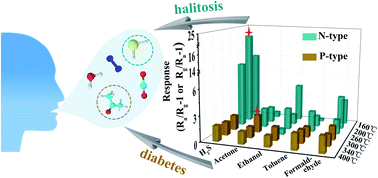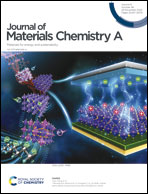Individual gas sensor detecting dual exhaled biomarkers via a temperature modulated n/p semiconducting transition†
Abstract
The newly-emerged breath sensing detection of disease biomarkers (e.g., H2S and acetone) offers rapid and noninvasive early diagnosis of diseases (e.g., halitosis and diabetes). Utilizing a single sensor to monitor dual biomarkers may contribute to both miniaturized size and multi-detection if implemented, but remains challenging. Here, interconnected BiFeO3/Bi25FeO40 nanoparticles (NPs, ∼22.5 nm in diameter) synthesized via combined microwave hydrothermal and annealing methods have been developed to selectively detect dual biomarkers of halitosis and diabetes. The selective detection has been modulated by an n/p semiconducting transformation, and has been experimentally observed and theoretically interpreted, in which electron–hole pairs are modulated due to the synergistic effect of temperature-dependent adsorbed oxygen molecules and semiconducting band bending. Remarkably, the sensor prototypes enable the selective detection of both H2S (n-type mode) and acetone (p-type mode) biomarkers with superior stability and a ppb-level detection limit. Furthermore, practical human breath has been experimentally simulated. Critically, the sensors with a waterproof membrane have been tested by immersing them into water. Our strategy of the detection of dual exhaled biomarkers by a single gas sensor may contribute to the integration and miniaturization of sensors, for upcoming intelligent medical treatment.



 Please wait while we load your content...
Please wait while we load your content...